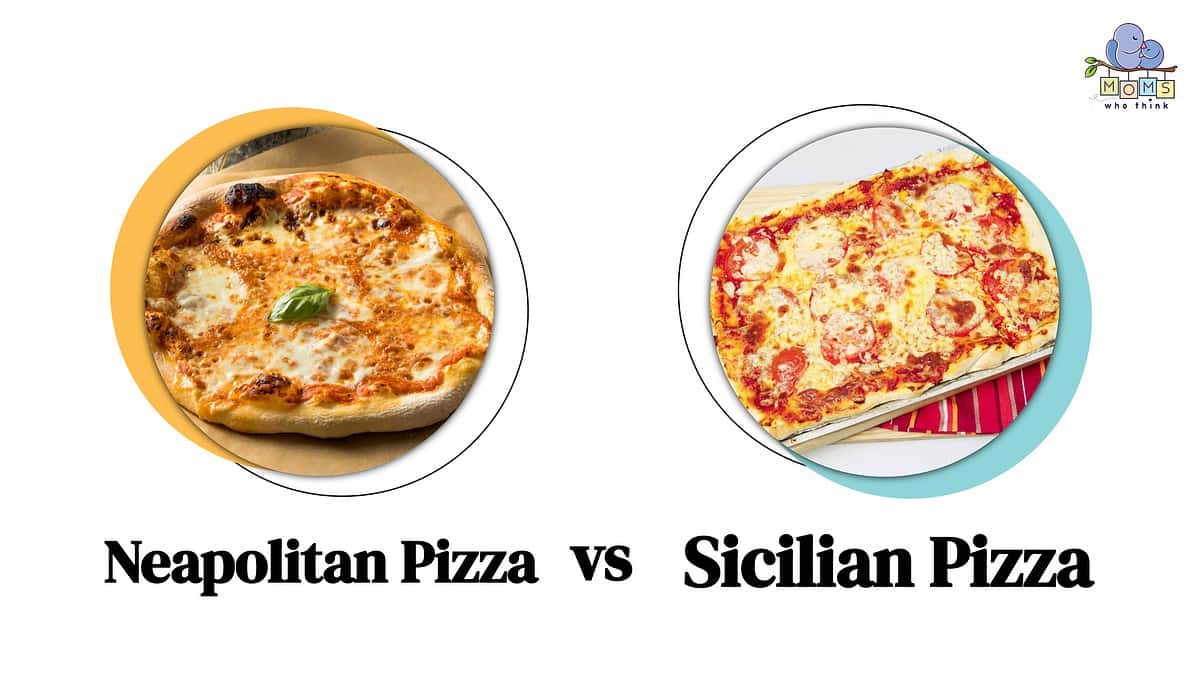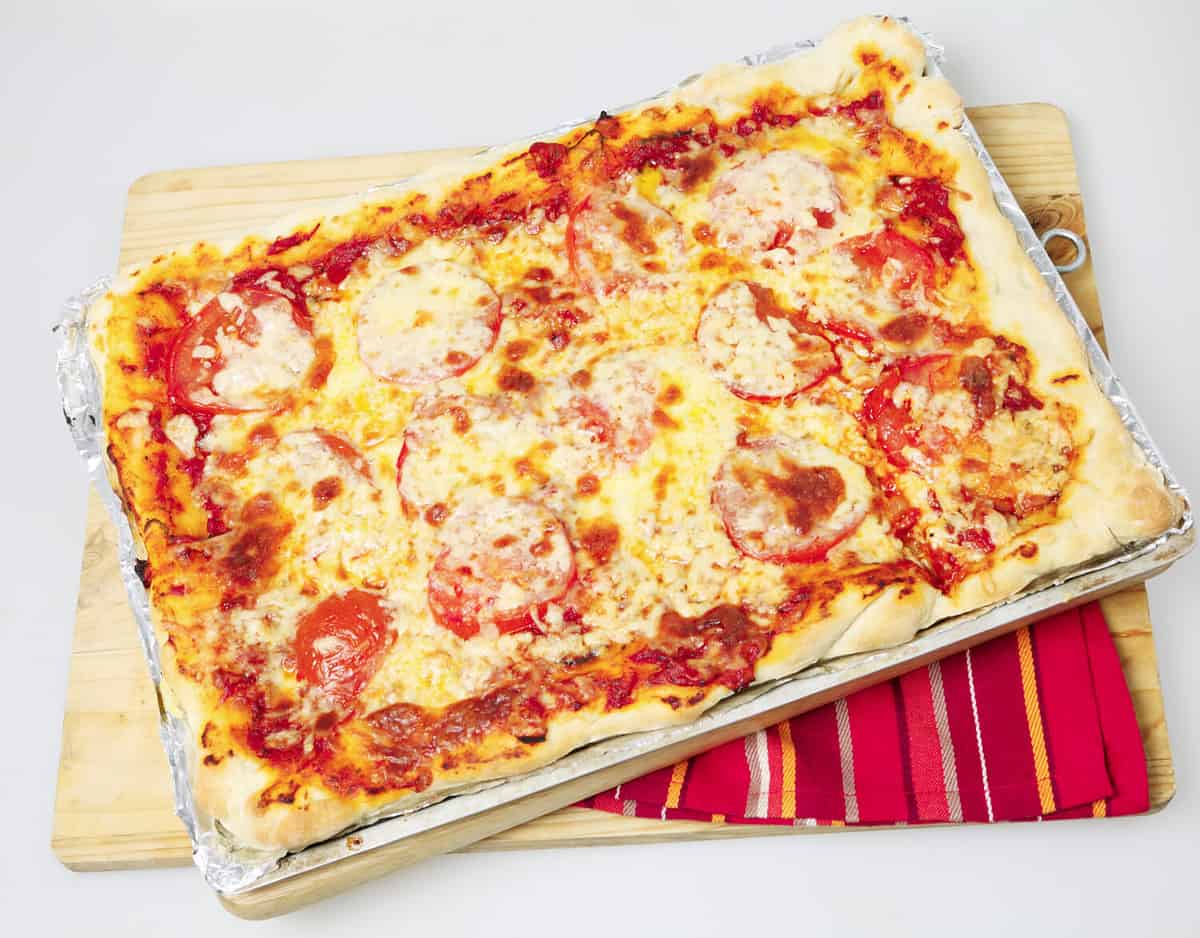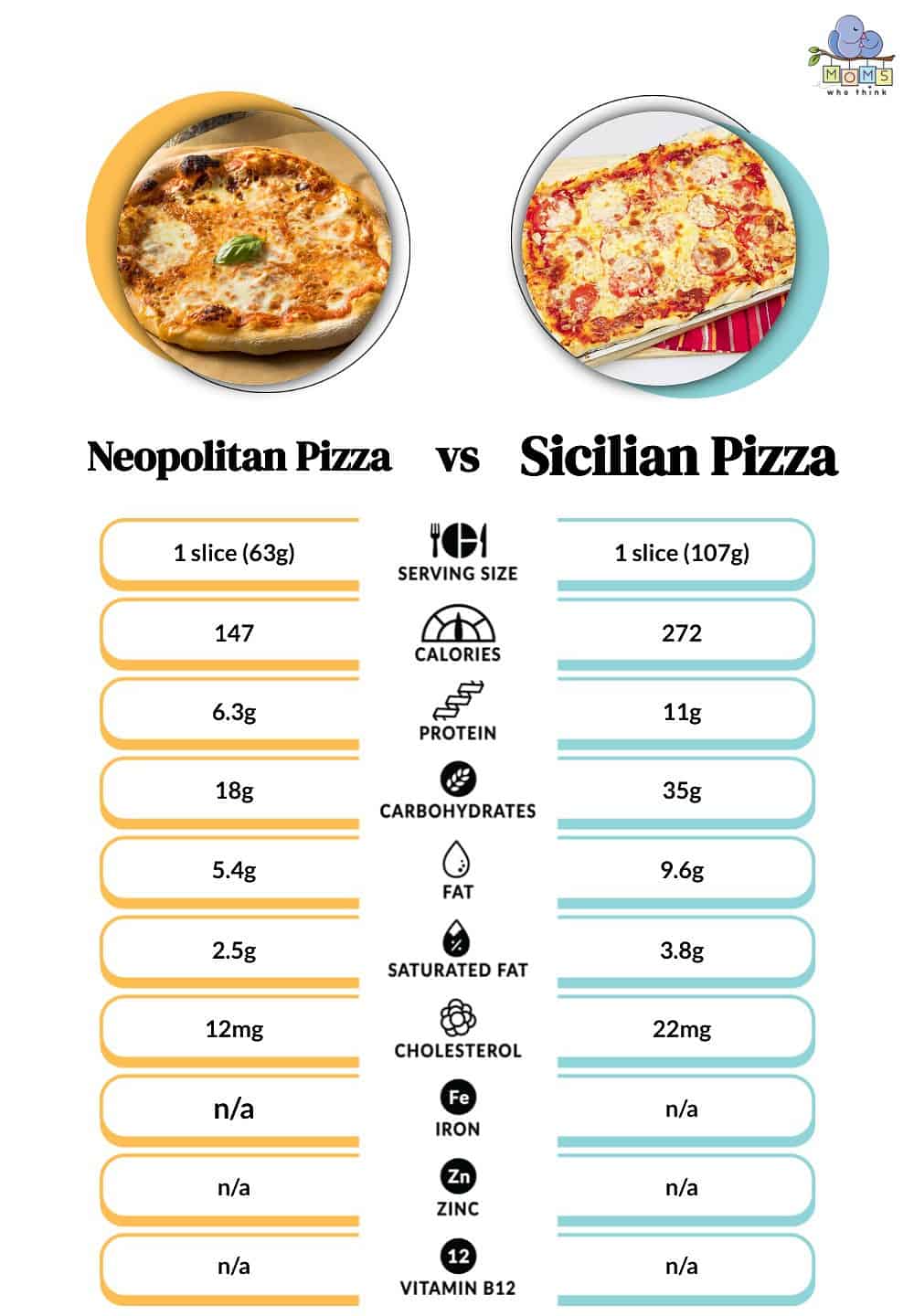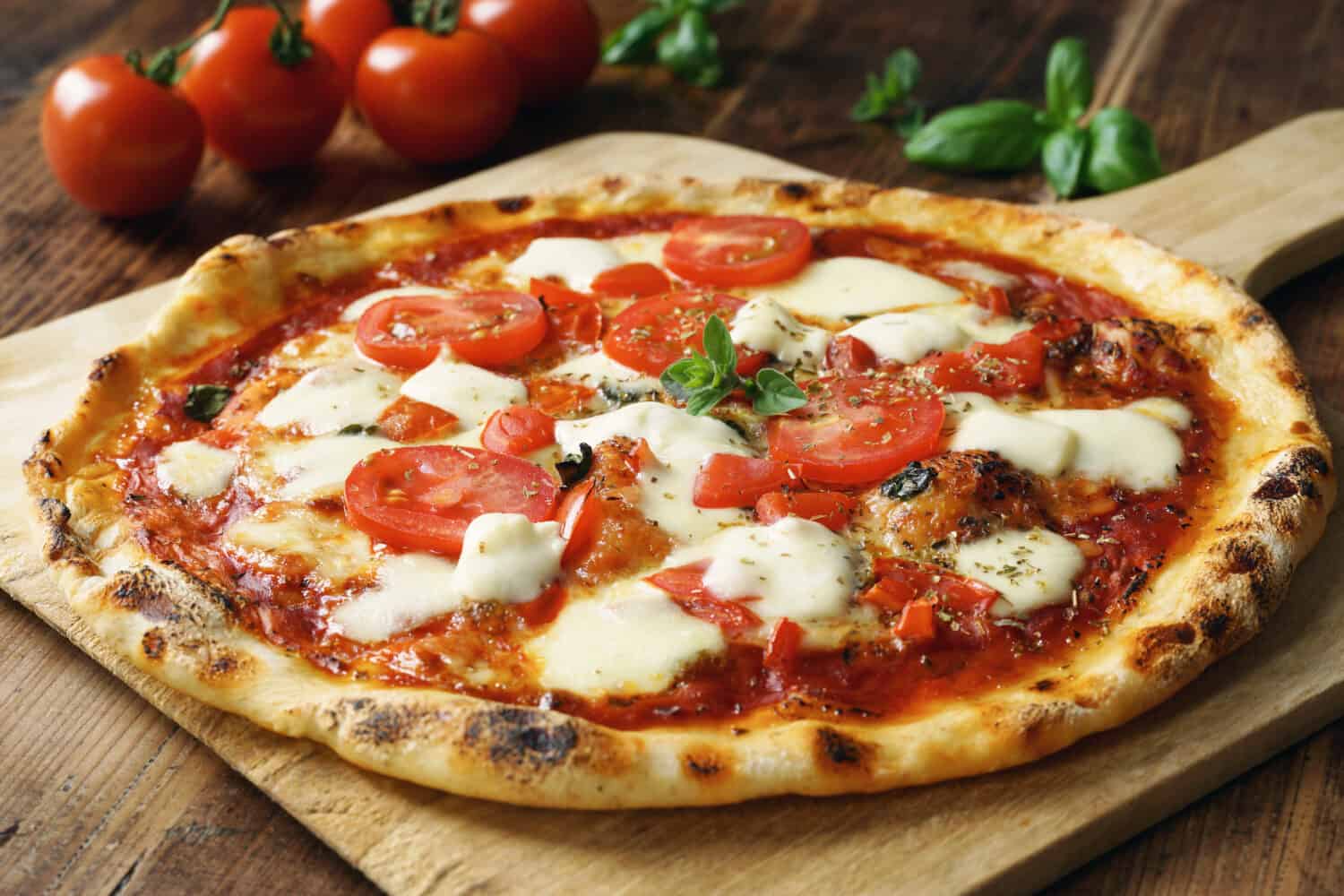Whether you have a hectic schedule or you need a break from the kitchen, you probably order a pizza from the local pizza place. But where did this pizza originate? And what's the difference between some of the styles? Two specific pizza types are Neapolitan and Sicilian.
These two types of pizza could not be more unique from each other! For starters, Neapolitan pizza has fewer, simpler ingredients, while Sicilian pizza has a variety of toppings. But these aren't the only differences between the two.
If you're curious about what to order the next time you enjoy pizza night, let's take an in-depth look at what sets these two popular pizza choices apart. Here's everything you need to know about Neapolitan and Sicilian pizza.

What is Neapolitan Pizza?
Neapolitan pizza originated in Naples, Italy and in Italian, the pizza is called “pizza Napoletana.” This type of pizza is meant to be light and fresh, topped with only tomato sauce, mozzarella, and basil. Typically, this pizza has more sauce than toppings. The crust is also only made with simple ingredients like flour, yeast, water, and salt.
A Neapolitan pizza is small in size and is cooked at a very high temperature. This creates a light and crispy crust that bubbles up and can be charred in some areas. Interstingly, in order to be certified to make and serve authentic Neapolitan pizza, you must receive authentication from the Associazione Verace Pizza Napoletana. Many restaurants aren't certified, so what you'll receive is a Neapolitan-style pizza that still tastes delicious but doesn't have to follow the strict rules of the AVPN.
What is Sicilian Pizza?
There are two different types of Sicilian pizza: Authentic Sicilian which originated from Sicily, Italy, and New York-style Sicilian pizza. Both are very similar in taste, preparation, and texture and are known for their thicker crust and hearty toppings. The only difference between the two is the ingredients used in the sauce and the type of cheese that's used on top. New York style uses tomato sauce, whereas Italian Sicilian pizza sauce is made from herbs, spices, onions, tomatoes, and anchovies. Additionally, Italian pizza uses cheese made from goat or sheep's milk, while New York style uses fresh mozzarella.
Regardless of where your Sicilian pizza comes from, you'll notice that this type of pizza is shaped in a rectangle. Its thicker, sponge-like crust also allows it to hold heartier toppings, including meats, vegetables, and larger amounts of cheese.

©Paul Cowan/Shutterstock.com
Neapolitan Pizza vs. Sicilian Pizza: What are the Differences?
From crust thickness to toppings and shape, there are many things that set these two types of pizza apart. Let's take a closer look at 3 key differences:
Origin and History
While both of these pizzas originated in Italy, their origin story and history are quite different.
Neapolitan pizza hails from Naples, Italy, where flatbreads have been made dating back to the 1600s. It wasn't until 1889 that baker Raffaele Esposito created what is known today as the Neapolitan pizza. He receives the credit for creating this pizza as he prepared it for the current king and queen of Savoy, who visited Naples. The pizza was made with the traditional Italian colors: Red (from the tomatoes), white (from the cheese), and green (from the basil). This is what's traditionally known as the Neapolitan pizza today, but it is also called the Margherita pizza as it was named after Queen Margherita.
While the exact history of Sicilian pizza is unknown, it's thought to have originated in Palmero City, Sicily, Italy. It was originally called “sfincione” which loosely translated to “think sponge.” This is the type of pizza that was brought to the United States by Sicilian immigrants and has been modified to incorporate various types of crust covered with sauce and cheese.
Crust and Shape
While crusts of both Neapolitan and Sicilian pizza have the same base ingredients, they're prepared and shaped differently.
Neapolitan is known for its light, crispy crust that's made from simple ingredients and shaped into a small circle. This pizza is also baked for just a few moments at a high temperature, so the crust tends to bubble and can have char marks in some places. Sicilian pizza crust, on the other hand, is heavier, thicker, and shaped into a rectangle. Its crust also has a softer texture and needs to be cooked longer to make sure it's baked appropriately.
Toppings and Ingredients Used
Each pizza has its own unique toppings and ingredients used. Some of the ingredients overlap, but overall, these pizzas are quite different.
Neapolitan pizza has a lighter, more tomato-based sauce and is covered with only a few simple ingredients like cheese and vegetables. It's not very common to find meat on this type of pizza either. Sicilian pizza, however, can hold a heartier sauce and additional toppings due to its thicker crust. This type of pizza is where you'll find sausage, mushrooms, pepperoni, and other various toppings.
Neapolitan Pizza vs. Sicilian Pizza: Nutritional Value
Because Neapolitan pizza is generally lighter and made with only a few whole ingredients, it's often viewed to be a healthier option. Below is a full nutritional comparison where you'll see that Neapolitan pizza has fewer calories, carbs, and fat. Keep in mind that exact nutritional information can vary depending on the brand and type of pizza you're consuming.

©
Baking Methods for Both Pizzas
When it comes to making pizza, a pizza oven can improve the flavor and create an authentic experience. If you're looking to make truly genuine Neapolitan pizza, a pizza oven is actually a requirement!
A pizza oven isn't necessary when you're making pizza at home, however. Just keep in mind that Neapolitan pizza will have a thinner crust, which will require less baking time. In general, this type of pizza can handle a higher cooking temp, but keep an eye on it to make sure it doesn't burn. Sicilian pizzas can handle a longer cooking time because they have a thicker crust. This type is generally easier to cook at home in your oven.
Different Types of Neapolitan Pizza
As with any pizza, there are varying flavors and types. While there are many variations that aren't recognized as authentic Neapolitan pizzas, here are the most pure forms:
- Margherita: The most commonly known variation of the Neapolitan pizza that's topped with tomato, mozzarella, fresh basil, and olive oil.
- Marinara: Topped with garlic, oregano, tomato, and olive oil
- Margherita Extra: Also includes tomato, basil, and olive oil, but uses mozzarella di bufala (buffalo milk mozzarella) instead.
- Bianca: Uniquely topped with rosemary in addition to garlic and olive oil
Different Types of Sicilian Pizza
There are many different variations of Sicilian pizza depending on the toppings you choose and how it's prepared. This type also has different variations depending on where it originated from. Here are a few common Sicilian pizza types:
- Traditional sfincione: This type is the original that was created in Sicily.
- New York-style Sicilian: This slight variation from the original was brought over by Sicilian immigrants and also has a thinner crust than the traditional recipe.
- Detroit-style Sicilian: Keeps the thicker crust feature but tends to have a richer sauce and meaty toppings like pepperoni, sausage, and ham.
Final Thoughts
When it comes to pizza, there are a plethora of different options to choose from. In general, Neapolitan-style pizza is known for its thin, crispy, circular crust and light and simple toppings. Sicilian pizza has a thicker, rectangular crust and can hold heartier toppings and causes. Additionally, most pizza that you will find commercially today stems from Sicilian pizza. Whichever style you choose, you're sure to be in for a delicious Italian treat!
Print
Sicilian Pizza with Balsamic Glaze
Ingredients
For the Dough:
- 4 cups all-purpose flour
- 1 packet (2 1/4 teaspoons) active dry yeast
- 1 1/2 cups warm water
- 2 Tablespoons olive oil
- 1 teaspoon sugar
- 1 teaspoon salt
For the Toppings:
- 1 1/2 cups pizza sauce
- 2 cups shredded mozzarella cheese
- 1/2 cup grated Parmesan cheese
- 1/2 cup sliced pepperoni
- 1/2 cup sliced bell peppers
- 1/2 cup sliced red onions
- 1 teaspoon dried oregano
- 2 Tablespoons balsamic glaze
- Olive oil for drizzling
Instructions
For the Dough:
In a bowl, combine warm water, sugar, and yeast. Let it sit for about 5 minutes until it becomes frothy.
In a large mixing bowl, combine flour and salt. Make a well in the center and pour in the yeast mixture and olive oil. Mix until a dough forms.
Knead the dough on a floured surface for about 5-7 minutes until it becomes smooth and elastic.
Place the dough in a lightly oiled bowl, cover it with a damp cloth, and let it rise in a warm place for about 1-1.5 hours or until it doubles in size.
For Assembling the Pizza:
Preheat your oven to 425°F (220°C).
Punch down the risen dough and transfer it to a greased 9×13-inch baking pan. Press the dough evenly to cover the bottom of the pan.
Spread pizza sauce over the dough, leaving a small border around the edges.
Sprinkle mozzarella and Parmesan cheese over the sauce. Add pepperoni, bell peppers, and red onions evenly.
Drizzle two tablespoons of balsamic glaze over the assembled pizza. Create a decorative pattern or distribute it evenly.
Sprinkle dried oregano over the top and drizzle with olive oil.
Bake in the preheated oven for 20-25 minutes or until the crust is golden and the cheese is bubbly and slightly browned.
Nutrition
- Calories: 390
- Sugar: 6 g
- Sodium: 800 mg
- Fat: 15 g
- Carbohydrates: 47 g
- Fiber: 2 g
- Protein: 15 g
- Cholesterol: 30 mg
The image featured at the top of this post is ©V. Matthiesen/Shutterstock.com.


